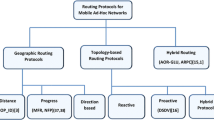Abstract
A mobile ad hoc network consists of wireless hosts that may move often. Movement of hosts results in a change in routes, requiring some mechanism for determining new routes. Several routing protocols have already been proposed for ad hoc networks. This paper suggests an approach to utilize location information (for instance, obtained using the global positioning system) to improve performance of routing protocols for ad hoc networks. By using location information, the proposed Location‐Aided Routing (LAR) protocols limit the search for a new route to a smaller “request zone” of the ad hoc network. This results in a significant reduction in the number of routing messages. We present two algorithms to determine the request zone, and also suggest potential optimizations to our algorithms.
Similar content being viewed by others
References
I.F. Akyildiz, S.M. Joseph and Yi-Bing Lin, Movement-based location update and selective paging for PCS networks, IEEE/ACM Transactions on Networking 4 (1996) 94–104.
C. Alaettinoglu, K. Dussa-Zieger, I. Matta and A.U. Shankar, MaRS user's manual – version 1.0, Technical Report TR 91-80, The University of Maryland (June 1991).
S. Basagni, I. Chlamtac, V.R. Syrotiuk and B.A. Woodward, A distance routing effect algorithm for mobility (DREAM), in: Proc. of ACM/IEEE MOBICOM '98(1998).
J. Broch, D.A. Maltz, D.B. Johnson, Y.-C. Hu and J. Jetcheva, A performance comparison of multi-hop wireless ad hoc network routing protocols, in: Proc. of MOBICOM '98(1998).
S. Corson, S. Batsell and J. Macker, Architectural considerations for mobile mesh networking (Internet draft RFC, version 2), in: Mobile Ad-hoc Network (MANET) Working Group, IETF(1996).
S. Corson and A. Ephremides, A distributed routing algorithm for mobile wireless networks, Wireless Networks (1995) 61–81.
S. Corson and J. Macker, Mobile ad hoc networking (MANET): Routing protocol performance issues and evaluation considerations (Internet-draft), in: Mobile Ad-hoc Network (MANET) Working Group, IETF(1998).
S.R. Das, R. Castaneda, J. Yan and R. Sengupta, Comparative performance evaluation of routing protocols for mobile, ad hoc networks, in: Proc. of IEEE IC3N '98(1998).
B. Das, E. Sivakumar and V. Bhargavan, Routing in ad-hoc networks using a spine, in: Proc. of IEEE IC3N '97(1997).
G. Dommety and R. Jain, Potential networking applications of global positioning systems (GPS), Technical report TR-24, The Ohio State University (1996).
R. Dube, C.D. Rais, K.-Y. Wang and S.K. Tripathi, Signal stability based adaptive routing (SSA) for ad hoc mobile networks, IEEE Personal Communications 4(1) (1997) 36–45.
GPS and precision timing applications, available via WWW at URL: http://wwwtmo.external.hp.com/tmo/pia/ infinium/PIATop/Notes/English/5965-2791E.html
Z.J. Haas and M.R. Pearlman, The zone routing protocol (ZRP) for ad hoc networks (Internet-draft), in: Mobile Ad-hoc Network (MANET) Working Group, IETF(1998).
T. Imielinski and J.C. Navas, GPS-based addressing and routing, Technical report LCSR-TR-262, Rutgers University (March, updated August 1996).
Iowa State University GPS page, available via WWW at URL: http://www.cnde.iastate.edu/gps.html
M. Jiang, J. Li and Y.-C. Tay, Cluster based routing protocol (CBRP) functional specification (Internet-draft), in: Mobile Ad-hoc Network (MANET) Working Group, IETF(1998).
D.B. Johnson and D.A. Maltz, Dynamic Source Routing in Ad Hoc Wireless Networks(Kluwer Academic, 1996).
D. Johnson, D.A. Maltz and J. Broch, The dynamic source routing protocol for mobile ad hoc networks (Internet-draft), in: Mobile Adhoc Network (MANET) Working Group, IETF(1998).
Y.-B. Ko and N.H. Vaidya, Using location information to improve routing in ad hoc networks, Technical report 97-013, Texas A&M University (1997).
Y.-B. Ko and N.H. Vaidya, Location-aided routing in mobile ad hoc networks, Technical report 98-012, Texas A&M University (1998).
Y.-B. Ko and N.H. Vaidya, Location-based multicast in mobile ad hoc networks, Technical report 98-018, Texas A&M University (1998).
Y.-B. Ko and N.H. Vaidya, Location-aided routing (LAR) in mobile ad hoc networks, in: Proc. of MOBICOM '98(1998).
P. Krishna, M. Chatterjee, N.H. Vaidya and D.K. Pradhan, A clusterbased approach for routing in ad hoc networks, in: Proc. of USENIX Symposium on Location Independent and Mobile Computing(1995).
Metricom Web Page, available via WWW at URL: http://www. metricom.com
J.C. Navas and T. Imielinski, Geocast – geographic addressing and routing, in: Proc. of ACM/IEEE MOBICOM '97(1997).
NAVSTAR GPS operations, available via WWW at URL: http:// tycho.usno.navy.mil/gpsinfo.html
V.D. Park and S. Corson, A highly adaptive distributed routing algorithm for mobile wireless networks, in: Proc. of INFOCOM '97(1997) pp. 1405–1413.
V.D. Park and S. Corson, Temporally-ordered routing algorithm (TORA) version 1 functional specification (Internet-draft), in: Mobile Ad-hoc Network (MANET) Working Group, IETF(1998).
B.W. Parkinson and S.W. Gilbert, NAVSTAR: global positioning system – ten years later, Proceedings of the IEEE 71(10) (1983) 1177–1186.
C.E. Perkins and P. Bhagwat, Highly dynamic destination-sequenced distance-vector routing (DSDV) for mobile computers, in: Proc. of ACM SIGCOMM '94 Symposium on Communication, Architectures and Protocols(1994) pp. 234–244.
C.E. Perkins and E.M. Royer, Ad hoc on demand distance vector (AODV) routing (Internet-draft), in: Mobile Ad-hoc Network (MANET) Working Group, IETF(1998).
S. Ramanathan and M. Steenstrup, A survey of routing techniques for mobile communication networks, Mobile Networks and Applications (1996) 89–104.
R. Sivakumar, P. Sinha and V. Bharghavan, Core extraction distributed ad hoc routing (CEDAR), in: Proc. of INFOCOM '99(1999).
M. Spreitzer and M. Theimer, Providing location information in a ubiquitous computing environment, in: Proc. of Symposium on Operating System Principles(1993).
C.-K. Toh, A novel distributed routing protocol to support ad-hoc mobile computing, Wireless Personal Communication (1997).
M. Weiser, The computer for the 21st century, Scientific American (1991) 94–104.
Rights and permissions
About this article
Cite this article
Ko, Y., Vaidya, N.H. Location‐Aided Routing (LAR) in mobile ad hoc networks. Wireless Networks 6, 307–321 (2000). https://doi.org/10.1023/A:1019106118419
Issue Date:
DOI: https://doi.org/10.1023/A:1019106118419




